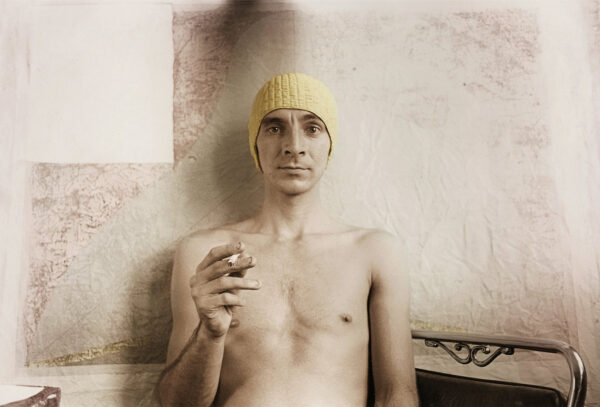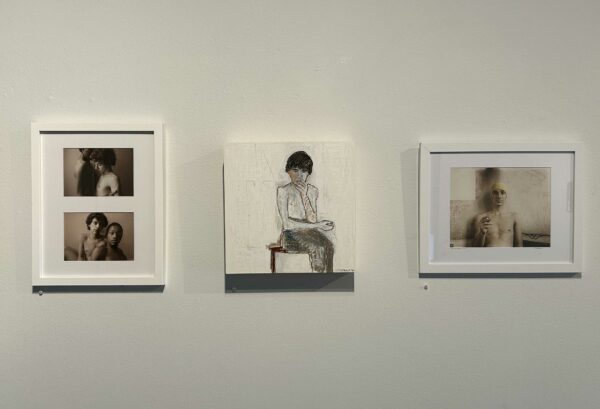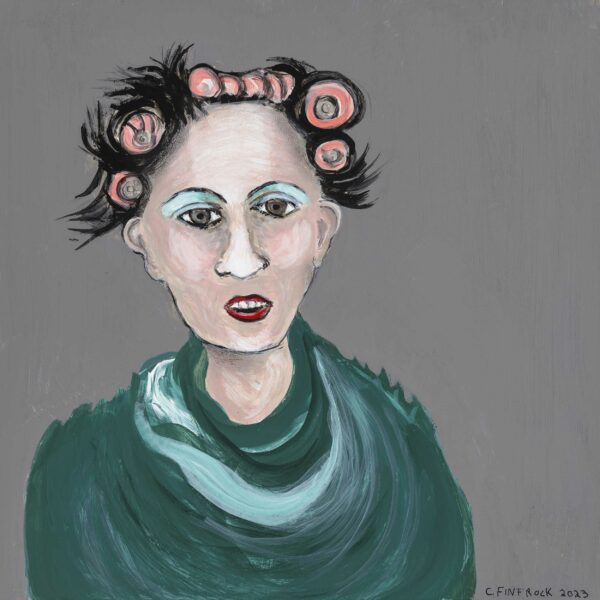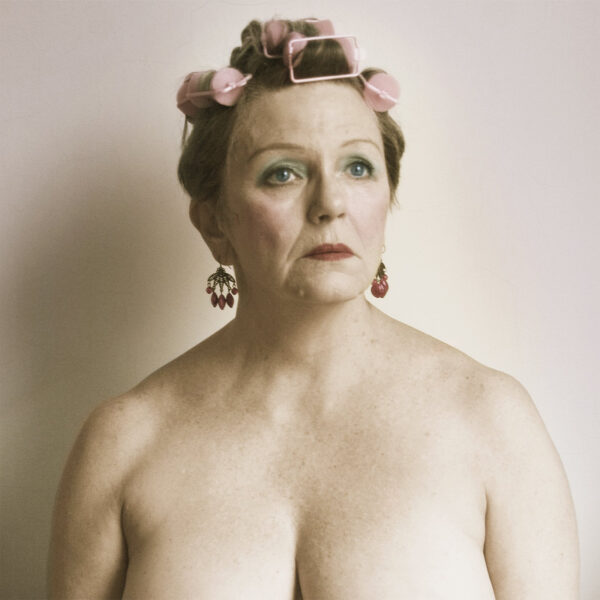Currently on view at Link & Pin in South Austin is Synchronicity, a collection of recent portraits by painter Cheryl Finfrock and photographs by Eva Weiss dating back to 1972. On a crusade for universality, the exhibition ties the artists’ breadths together through their common subjects, which focus on the inelegance of being human. This candid exploration of people before and between performances or seminal moments combines incredibly similar but independently created works — a meaningful coincidence.
Finfrock and Weiss reference Carl Jung’s definition of “synchronicity” in the exhibition statement: The experience of two or more events that are causally unrelated or unlikely to occur by chance, yet are experienced as occurring together in a meaningful manner. Synchronicity makes Jung’s theory tangible by pairing similar works by the artists. The show, being so quiet and subdued and not pursuing a clear visual theme aside from portraiture, attempts to prove Jung’s theory.
The portraits flow through various subjects, but looking in no particular order, viewers can still see they illustrate similar aspects of the everyday. The artists advocate for the collective unconscious and hope for universally understood reactions. Without the epigraph, the exhibition is incredibly nuanced, and the artists’ hyper-specific overarching theme may be lost or too loosely interpreted by art-goers.
While Finfrock tends to showcase the awkwardness of being human, Weiss’ works lean toward theatrical and dreamlike depictions of mundane moments, often focusing on queerness. Classical painters like Vermeer are noted inspirations for her carefully posed and muted sepia-toned portraits. Finfrock’s approach incorporates bold, expressionistic brushstrokes akin to Alice Neel to emphasize the imperfection of the ordinary.
The artists overlap their subject matters most notably in Finfrock’s Later That Morning (2023), which sits between Weiss’ Lois With Rollers 2014 Lois Weaver (2014) and Lois With Rollers 1984 Lois Weaver (1984). The three are images of two placid-faced women — an anonymous woman and Lois Weaver, twice — crowned with pink sponge rollers. The subjects of the works are carefully positioned; Lois gazes to the upper right in both images, and Finfrock’s character, dressed similarly, faces completely forward. Lois, shown 30 years apart, has the thin and perfectly arched brows of Classical Hollywood in each of the photos and wears heavy blush, blue eyeshadow, red-painted lips, and chandelier earrings. Weiss’ photographs are so elaborate that her characters seem to be imitating art. Finfrock’s subject is much more frenzied, with her flush skin and tufts of black hair sticking out from her rollers.
The founders of the New York City queer performance art theater Split Britches are gathered and costumed for a show with elaborate ball gowns and hairstyles in Upwardly Mobile Home Split Britches Peggy Shaw Lois Weaver and Deb Margolin (1984). Lois, in the center, is posed with an ornate beaded headpiece draping past her shoulders. Subjects’ casual ostentation gives some of Weiss’ photographs a hint of humor, but not overtly. Several of her images document behind-the-scenes moments from Split Britches, where eccentrics rewrite existing stories into satires. Like the exhibition, their renditions focus on moments and relationships rather than plot.
Finfrock’s full-body portrait of a man hunched on a stool and clutching a piece of string, His Last Thread (2021), hangs alongside Daniel Allen, photographed in 1974 by Weiss. Allen is seated against a textured backdrop, nonplussed, wearing nothing but a yellow quilted cap with a cigarette between his fingers. Completing the three artworks is a diptych, Bill T. Jones and Arnie Zane Diptych (1972), in which the pair, pictured from the torso up, nude, lean into each other intimately. The solid, dark backdrop and simplicity of Jones and Zane are reminiscent of Baroque portraits — a style used several times in Weiss’ artworks for the exhibition. Though each of the three works are unnamed moments, they’re all clearly pensive.
Elevator’s Pause Courted an Unbreakable Silence (2023) by Finfrock is a simplistic painting of five close-ups of people riding together, none of whom are conversing. Everyone in the elevator has a distinct personality, but for a few minutes, they’re sharing the same space. The unspoken camaraderie expressed by Finfrock in this painting is akin to walking in the same direction as others for a few blocks, sitting in a theater to see a show, or riding a plane or train full of strangers. Pulling diverse individuals together, the painting is representative of the exhibition physically and also supports Jung’s theory.
Beyond the show’s physical curation, its title attempts to solidify the idea that people gravitate toward similar ideas and consider them worth capturing. Jung believed in the idea of the collective unconscious — that there are unconscious and unspoken commonalities between people across the world. Thought structures are repeated, just as Weiss and Finfrock selected the same subjects by chance. However, the veracity of Jung’s theory can only be proven by who stands before the artworks.
Synchronicity is on view at Link & Pin in Austin through March 23, 2024.






